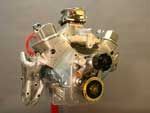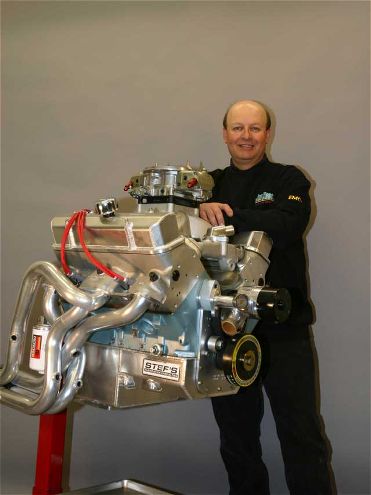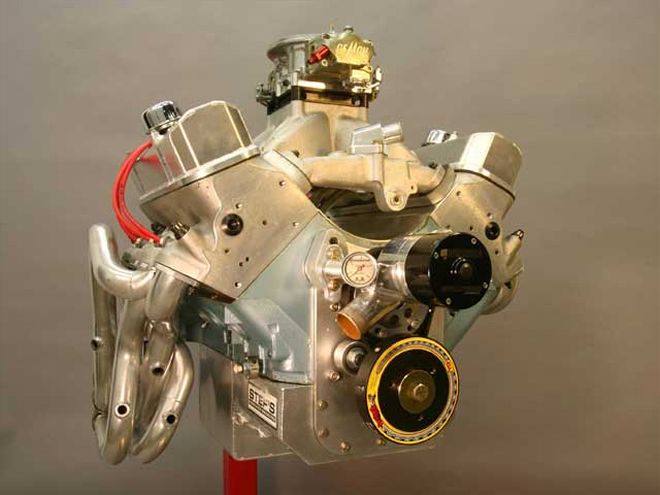
 Famed Pro Stock engine builder Jon Kaase built a 507-cube Pontiac engine that posted big dyno numbers on pump gas.
Famed Pro Stock engine builder Jon Kaase built a 507-cube Pontiac engine that posted big dyno numbers on pump gas.
For the last four years, Popular Hot Rodding magazine has put on the Engine Masters Challenge. This competition pits a select group of engine builders against each another to build the most powerful pump-gas engine and prove it on the dyno, while adhering to a strict set of rules that includes engine parameters, which change each year. Anyone can apply, and usually 40 or so builders are selected to compete. Their buildups can represent anything from typical Chevys and Fords to Mopars, AMCs, Olds, Buicks, Cadillacs, and--yes--even our beloved Pontiacs.
Hobbyists who have followed the Engine Masters series each year have also seen a trend developing--Jon Kaase Racing Engines (JKRE) of Winder, Georgia, has won the competition the last two years with variations of Ford Engines--a Lima-based, 468-inch big-block in 2003, followed by a 407-cubed Cleveland small-block in 2004.
Kaase is a serious Pro Stock engine builder who has been a major player in the sport since the late '70s. His shop's specialties are big-block Fords, Chevys, and Mopars, but as you will soon see, it's not limited to them.
So why did an engine builder who has won with Fords for the past two years decide to go with a Pontiac this time around? "I've always had a soft spot for Pontiacs," Kaase says. "Back when I was 16, my sister's boyfriend took me for a ride in his '64 GTO, and it was a life-altering experience. Its power, its styling--that '64 had everything a guy who wanted to go fast and look good doing it could want! So when the opportunity came once again to compete in Engine Masters, I decided to explore the possibility of building a Pontiac. What I found in my research was that the Pontiac aftermarket had come a long way over the past few years. With the new IAII block and the new Tiger heads, I felt that a Pontiac would not only be competitive in this competition, but could win it."
 AllPontiac.com's IAII block with a 4.310-inch bore and a Bryant Racing Billet crank with a 4.350-inch stroke is the basis of the buildup, and a set of fresh Tiger Heads from AllPontiac.com provided well over 400 cfm intake flow.
AllPontiac.com's IAII block with a 4.310-inch bore and a Bryant Racing Billet crank with a 4.350-inch stroke is the basis of the buildup, and a set of fresh Tiger Heads from AllPontiac.com provided well over 400 cfm intake flow.
Unfortunately, a triple crown was not on the dyno sheets for JKRE in 2005, but the Fourth-Place finish, though quite an achievement given the competition, has nothing to do with the fact that the engine is a Pontiac and not a big-block Ford. Truth be told, Kaase's Pontiac was the top-qualifying engine going into the final round.
Then, it lost power on each of its three runs in the final. At first, Kaase thought he had hurt the engine by tuning too close to the edge, given the pump-gas requirement and its 12.4:1 compression. He later learned that Pontiacs don't hurt that easily, and the problem was simply a piece of a carb gasket that got sucked into a main jet. Had that not happened, chances are JKRE would have enjoyed three Engine Masters wins in a row, and the Pontiac would have risen to the top of the heap. Regardless of that single setback, this engine has over 200 dyno pulls on it and hasn't scattered its contents. It has produced peak numbers of 851.7 hp and 786.2 lb-ft of torque (on 93-octane fuel at JKRE). It has over 700 lb-ft of torque from 3,700 rpm through 6,300 rpm--enough to require a chiropractor for the driver when operating in a Pontiac with traction.
Given the engine's power production and what Kaase has accomplished, HPP thought you would be interested to see how it was all done, by tearing down the engine at JKRE. The following article reveals what went into the IAII-based, 507-cubed engine to run the number and what hoops had to be jumped through to meet the rule requirements of the competition.
A Question Of Compression
JKRE built the engine to run 12.4:1 compression on 91-octane fuel in the competition. Sounds pretty high, even with the heat-dissipation qualities of the aluminum Tiger heads. "Yes, it may ping and rattle a little bit," Kaase says, "but the engine has more cam than you would normally run on the street, which reduces cranking compression somewhat to ward off detonation. We also welded up the combustion chambers and reworked them to reduce volume to just 37 cc to gain quench area on each side of combustion chamber to further avoid detonation. Piston-to-deck height is +0.010, and the piston top, though it has a large dish to reduce compression, is shaped to mimic the combustion-chamber shape to increase quench area. The valves were Calico heat coated on the intake to reduce the heating of the mixture entering the chamber and on the exhaust to keep the valve from glowing red, and providing another possible origin for detonation. Running 28 degrees timing with 23 degrees initial up to 4,000 rpm and then adding in the final 5 degrees also reduces detonation slightly, but backing off the timing too much can really hurt power."
Modified Tiger Head Flow Lift (in)Intake (cfm)Exhaust (cfm)Int/Exh Flow Ratio (%) 0.200161110680.300248157630.400317205640.500366244660.600392263670.700410275670.750417280670.80042128367 These heads were tested on an SF-600 Flowbench at 28 inches of pressure at Howe Racing Heads, Inc. in Winder, Georgia.
Dyno Results RPMCorrected HPCorrected Torque 2500294.9619.63000355.8622.83500463694.84000558.4733.24500652.4761.45000745.9783.65200778.4786.25500798.6762.66000841.5736.66200851.7721.56500825.5667AVG621.7716.2 These results were taken from one of the myriad pulls Kaase made on his Superflow Model 901 engine dyno. Fuel octane was 93 for this pull, jets were 86 square, timing was 30 degrees total, the correction factor was 1.11:1, and the air inlet temp was 84 degrees.
Bottom-End Highlights
The bottom end is comprised of an interesting assemblage of components. Its IAII block was sleeved to reduce the bore size to 4.310 inches, as it was an early development block that had already been overbored prior to Jon receiving it. See the captions to learn more about this block's attributes.
Kaase also decided to reduce the main journal diameter to just 2.500 inches like a small-block Mopar, so he had to install inserts to reduce the main size from the as-delivered Pontiac 3.00 inches. Why even smaller mains? You may think it's to reduce friction, but Kaase says otherwise. "I reduced the main size so the crank wouldn't need so much oil and require higher pressure that would throw a lot of oil out of the short-block, since it's a wet-sump motor with no crankcase vacuum. I wasn't really worried about friction because the engine doesn't run at very high rpm." He also used Calico coating on the bearings so he could run slightly tighter clearances on the mains and rods to further reduce the amount of oil thrown out of the short-block. "The coating reduces friction, but will also catch dirt so it won't scratch the crank as much," he says.
Normally, small mains and a long stroke would raise concerns about crank strength, but Kaase handled that by ordering a Bryant Racing billet crank. "I knew the billet crank would hold up," he says, "and despite the long stroke it wouldn't flex because of the material and because it has counterweights in the center as well."
The rods feature a 2.00-inch big end and a 0.927-inch small end. They are 0.940 inch wide and a seemingly short 6.500 inches. "I'm not a fan of long rods," Kaase says. "I think shorter rods make the piston move faster at top-dead center, so if the engine is prone to detonation, getting the piston past TDC faster helps a little bit. With a 4.350 stroke, you can't fit much more rod and still have a piston with enough compression height to maintain the strength that I want." What about rod angularity causing increased side loading of the cylinder walls? Since AllPontiac.com specifies a minimum of 0.200 inch wall thickness with a 4.400 bore, it's not a problem with this block, according to Kaase.
Regarding weight reduction of reciprocating engine parts, Kaase says, "I didn't take time to make things light with this engine, because I felt durability was more important. Also, the acceleration rate on the dyno (330 rpm/second) is not that fast, so weight isn't really a big deal. For instance, the pistons weigh about 650 grams each--I would not want them lighter, because I want to maintain strength."
Speaking of the pistons, the custom CP slugs, aside from the design features mentioned previously, were also gas ported to ensure good ring seal. The pistons are drilled on the piston deck though to the top ring land behind the ring. When the piston rises and cylinder-pressure builds, some of that pressure enters those ports and pushes the ring out to seal more tightly against the cylinder wall.
Pertaining to the cam choice, Kaase says, "With a couple of years' data from other engines, we had somewhat of a baseline. We had two cams made for this engine--one with 257/261 degrees duration at 0.050 and the other with 261/268 degrees duration at 0.050. Though it didn't produce much more power than the other, I decided to go with the larger cam. The 107-degree lobe-separation angle was based on previous tests, and we tried different rocker ratios, but the 1.8:1 ratio, which happens to be the highest ratio allowed in the competition, made the most power."
Top-End Highlights
The Tiger heads were ported to improve flow, and the chambers were welded and reshaped to reduce volume. Some of the features of the original chambers were retained--like the heart shape--which should promote swirl, but Kaase says his reasoning was to provide more quench area. The spark plug is biased toward exhaust valve--the hottest part of the chamber--for a quicker burn, but Kaase says he would have rather had it more toward the center of the bore to improve flame propagation.
Howe Racing Heads was involved with the head porting with JKRE. "We had specific cross-section dimensions that we wanted at certain points, like the pushrod and at the short turn," Kaase says. "We used molds to determine what was needed." The as-delivered intake port had a 310cc volume and measured 2.600x1.300 inches at the intake flange. Kaase says they aren't much bigger now. For comparison, a Ram Air IV intake port measures 2.200x1.100 at the flange.
In discussing the intake manifold mods, Kaase said, "We radiused the entry from the carb flange into each port, and we did lots of porting near the gasket area to match the intake to the heads and spacers. When all was said and done, no work under the carb flange would have probably only cost us about 10 hp or less. For all the work we did there, we didn't gain much."
'05 Jeg's Engine Masters Challenge Results For JKRE
Average horsepower and torque production of each engine as measured from 2,500 to 6,500 over three pulls is totaled and then added together to arrive at an overall score.
Qualifying Avg. TorqueAvg. HP Run 1692599Run 2689596Run 3687595AVG689.33596.66Total Score1286.00
Final Avg. TorqueAvg. HP Run 1692598Run 2674582Run 3657564AVG674.33581.33Total Score1255.67
Tuning
Bottom End
Oiling and Cooling
Cam
Heads
Exhaust
Ignition
Induction
Flywheel
HPP Engine Buildup Worksheet
Bottom End
Oiling System
Heads
Cam
Induction
Ignition
Exhaust
Gaskets
Ancillary Components And/Or Procedures
Conclusion
And what of the fate of this engine?
Next year, the Engine Masters Challenge requirements stipulate 10.5:1 compression and 434 cubes in big- or small-block form and no roller cam bearings. Kaase says he may return with this same powerplant, modified to reflect the rules changes. For now, we'll have to just wait and see.
About Jon Kaase Racing Engines
Jon Kaase grew up in Cleveland, Ohio, and began racing at 16. He worked at an engine shop to learn how to build engines to run quicker while earning a degree in mechanical engineering. By 23, he took the next step and landed a position working for the legendary Dyno Don Nicholson in Atlanta. After learning even more from the master and making important contacts in the industry, Kaase opened his own shop in 1979.
Currently, Jon Kaase Racing Engines covers 8,000 feet on 2 acres of real estate in Winder, Georgia, just north of Atlanta. The business caters to about 25 or so IHRA Pro Stock cars running Ford, Chevy, or Mopar powerplants. A Kaase-powered Pro Stocker has won the IHRA Pro Stock Championship for 10 years running.